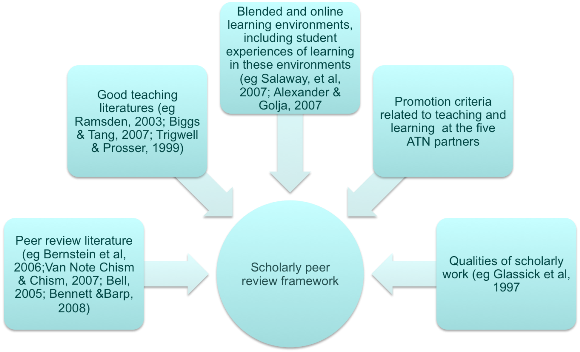The development of a scholarly framework for peer review in this project
1. Framework categories for peer review in blended learning environments
The summarised criteria used in our framework are:
- Clear Goals: for students’ learning and the design of the learning environment
- Current & Relevant Preparation: includes consideration of content, processes and student needs
- Appropriate Methods and their Implementation
- Effective Communication
- Important Outcomes: student learning and engagement, other intended and unintended outcomes, possible scholarly presentations or publication.
- Reflective Critique: including use of feedback and reflection for improvement (modified from Glassick et al’s (1997) qualities of scholarly work).
More detailed descriptions of the criteria were also needed to guide reviewers and reviewees in considering the qualities of these aspects of teaching that could be reviewed.
2. Context for this framework
Peer review in this project was seen as an activity that could contribute to peer learning as well as to the provision of evidence about teaching for recognition and reward. Development of a peer review framework commenced with defining the purposes and scope of peer review in relation to the aims of the project. The following initial assumptions informed the framework development:
- A framework for peer review of teaching in online and blended learning environments needs to allow for a wide diversity of teaching and learning contexts, from fully online subjects to subjects that are primarily offered face-to-face with some online components. We wanted to have a common framework that could be used for recognition and reward of teaching across contexts, rather than separate criteria for different aspects of teaching such as face-to-face classes, facilitating online learning or course design.
- A framework for peer review needs to focus on aspects of teaching which peers are well placed to observe and on which they can provide useful feedback and direct evidence.
- These aspects include the content that is taught and the appropriateness of teaching methods for the teaching context and resources available.
- Peer review evidence should complement but not replace evidence provided by students (see Harris et al, 2008).
- Peer review has the potential to consider evidence across the range of teaching activities.
- These include planning and preparation, teaching and learning activities, the outcomes of teaching and teachers’ reflections and actions taken to improve (see Biggs, 2003; Trigwell, 1995).
- Online and blended learning environments offer particular opportunities for review of evidence of student engagement in and learning from available learning opportunities.
- For peer review evidence to be useful for recognition and reward, it needs to focus on providing evidence for good teaching.
- It is important to distinguish between necessary practices that would be expected in all teaching, and good teaching, a scholarly practice that inspires high quality student learning and deserves to be recognised and rewarded.
The peer review framework and processes developed in this project complements existing peer review resources. In particular, we sought to avoid overlap with the ALTC project Peer review of online learning and teaching led by Dr Denise Wood, which was funded at the same time but with a different intended focus and outcomes.
3. Framework development
In developing the framework, the promotions criteria and related teaching descriptions of the five participating universities were summarised as a first step. There were broad commonalities in the aspects of teaching practice that were considered across the different institutions, but considerable differences in the specific criteria and the ways that they were presented. The relevant literature was also used along with the qualities of scholarly work, as depicted in Figure 1 below.


